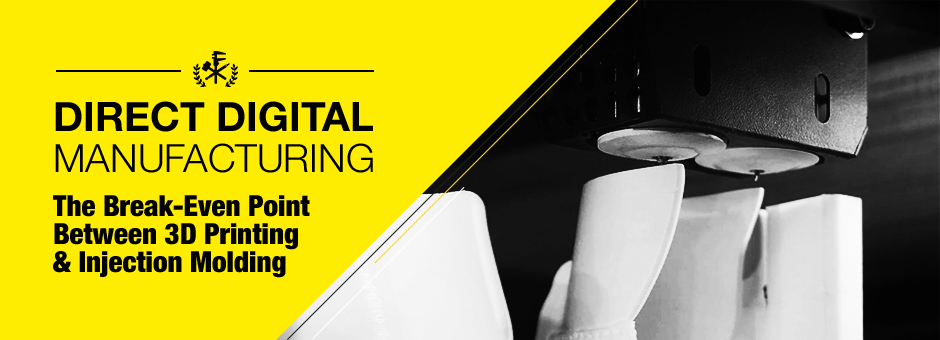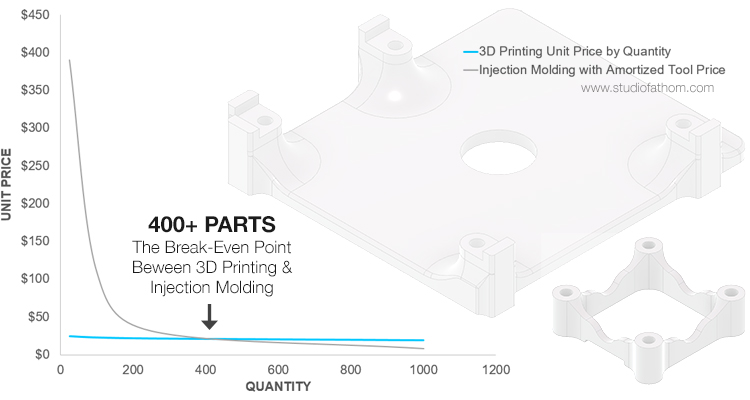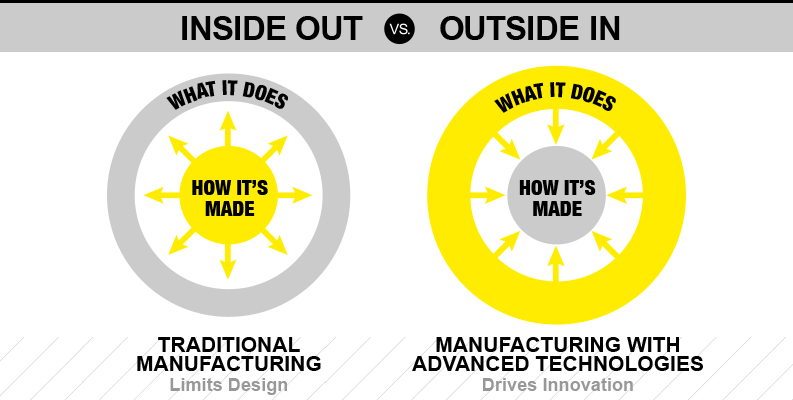Direct Digital Manufacturing (DDM) – Fathom
3D printing has traditionally only been thought of during the prototyping phase of product development, but designers and engineers should expect more from the additive technologies and materials available today. From tools for injection molding to jigs or fixtures to end-use parts, direct digital manufacturing continues to prove itself as a fundamental part of modern manufacturing. In a recent white paper published by Stratasys—“How to Design Your Part for Direct Digital Manufacturing”—Principal Systems Engineer Jim Comb explains, Traditional manufacturing methods, like machining and injection molding have many rules, restrictions and limitations. These rules don’t apply when using direct digital manufacturing. Designers are free to concentrate on the best design and not concern themselves with manufacturability.
3D Printing vs Injection Molding / / Read More
By augmenting traditional methods with 3D printing, companies are driving greater innovation and pushing the limits of manufacturing. In this interview, industry expert Rich Stump weighs in on direct digital manufacturing—what is it, why and when does it make sense, what are the benefits and how can a company augment traditional methods with additive technologies.

TOOL-LESS MANUFACTURING— MITIGATE RISK, LOWER COSTS, AND GAIN AGILITY Interview with Rich Stump, Industry Expert and Co-Founder at Fathom
What is direct digital manufacturing and do you see it becoming more widely adopted in the near future?

Stump: Direct Digital Manufacturing (DDM) is a process that uses 3D printing and additive manufacturing to produce end-use parts. As additive processes and materials have advanced, opportunities have opened up to use these technologies to produce customized manufactured parts. This progression in additive is making many projects viable that were previously victims of economy of scale and is allowing innovators to solve many high-value design, engineering and manufacturing challenges.
Direct digital manufacturing is becoming more widely adopted because of its ability to produce manufactured parts more quickly and cost effectively compared to traditional manufacturing methods such as injection molding—in a world built on speed, manufacturers can’t afford to lose ground.
When does a direct digital manufacturing strategy make sense? What are some of the benefits and disadvantages?

Stump: A DDM strategy can make sense in many different situations and application types. Typically, one major driver towards DDM is a high-value, lower production volume application. Given the speed and cost of the current additive technologies, it doesn’t make sense to use DDM for producing higher volume goods. In the example below, it is clear that injection molding is ideal for large production runs—it is also clear that DDM is ideal for low volume needs.
DDM eliminates the need to invest in a conventional “tool” that is the standard of traditional manufacturing. Creating a tool for injection molding is very costly (tens of thousands to hundreds of thousands of dollars) and typically takes four weeks or more to produce.
The chart below illustrates unit price per quantity for three different parts quoted two ways. The most cost-effective method was 3D printing for as much as approximately 400 parts. However, even at a thousand or more parts, DDM still has its advantages depending on the situation. For example, if part design changes happen often and speed is important, DDM allows for making what you need when you need it without waiting for one tool after another.

DDM creates a lower barrier of entry for new products, enabling products to reach the market without requiring a large inventory purchase upfront. By removing the barrier of time and creativity between design and production, DDM also eliminates costly penalties for tool redesign, making the product development process extremely flexible.
Fathom encourages our customers to use an outside-in approach (illustrated below) to design by focusing on how the product should function, rather than how it will be manufactured. This opens up product design, making viable designs that were previously constrained by the parameters of traditional manufacturing. By combining DDM with an outside-in approach, we have complete design freedom to manufacture virtually any shape. This enables customers to solve very specific, high-value problems.
Currently, the only limitations of DDM are material availability and surface finish. As it stands, injection molding has a wider selection of materials and can create a smoother surface finish than an additive manufactured part, but those gaps are shrinking every day.
How will direct digital manufacturing impact the future of product design and development?
Stump: DDM’s impact will continue to grow. More companies are looking for ways to create mass manufactured, customized products (referred to in the industry as “mass customization”). DDM reduces lead times and allows for more decentralized production, which will have significant impacts on communities across the globe. Ultimately, less rigid development and manufacturing means that more optimized, customized and specialized products suddenly become viable as the barriers of scale are torn down.

In the past, additive manufacturing has been used primarily for producing prototypes. In the near future, we will see the growth of DDM continue to push additive technologies further downstream in the manufacturing process, enabling more specialized end-use products.
